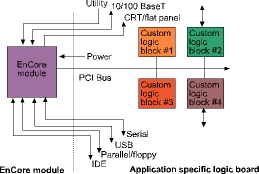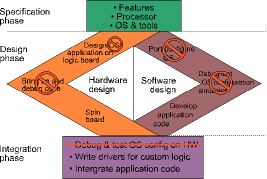
Using CPU modules, designers can link the benefits of an offtheshelf compute core with their custom I/O scheme. Ampro's Paul Rosenfeld explains.
The vast majority of commercially available, off-the-shelf single board computers follow one of a dozen or so standard buses and form factors introduced to the industry over the past 25 years. These include such well-known standards as VME, CompactPCI, PC/104, EBX and ATX motherboards. Using off-the-shelf SBCs significantly reduces time-to-market by eliminating the need to design and develop a custom CPU card. It also often eliminates the need to port or configure an operating system. That said, well over 99% of the 100 million or more 32-bit (and higher) embedded microprocessors shipped in 2001 were on custom CPU boards. Why is this?
Consider that most standard form factor single board computers are designed for use in systems incorporating a card cage and backplane. Those are critical for systems that integrate a variety of off-the-shelf I/O cards, or need to alter the I/O configuration during the production process based on individual end-customer needs. But thousands of designs do not need the flexibility to change I/O configuration during the production process. For those cases a complete single board solution is almost always more cost effective. Such designs can use off-the-shelf boards such as EBX, an ATX Motherboard, or a single VME or CompactPCI processor board with PMC I/O in a 1U package.
I/O drives custom choice
Those off-the-shelf solutions are only effective when the system requires a limited amount of standard I/O such as 10/100Base-T Ethernet and/or a video controller. When more I/O or, more importantly, special purpose custom I/O is required for an application, it is particularly difficult to expand these single board systems. That has led the vast majority of embedded developers to design and build custom single board solutions for their application using commercially available microprocessor components.
Other factors driving custom CPU designs include: limited off-the-shelf I/O choices; limited processor choice; cost of off-the-shelf single board computers; need for small footprint and/or custom placement of I/O connectors; the infamous NIH (not invented here) factor.
Building a custom single board solution comes with some downsides. Such designs take substantially longer to get to market, are faced with much higher technical risk and schedule uncertainty, and are much more costly to develop. What is needed is a way to get the time-to-market benefits of an off-the-shelf SBC while achieving the customisable I/O content, wide choice of state-of-the-art processors, product costs and small footprint usually associated with a full custom CPU solution.
Along such lines, several SBC manufacturers recently commercialised a concept used occasionally in custom designs. The approach involves abstracting the CPU portion of a design into a design element or macro-component that can be attached as a daughter card via standard bus interface to a custom 'baseboard'. Ampro's EnCore product family is an example of such a family of CPU 'modules'. Since the baseboard is a full custom design, there are no constraints regarding the form factor of the baseboard. Even the form factor of the CPU module itself is virtually irrelevant to the system packaging or overall design.
With EnCore the baseboard form factor is chosen to match the needs of system packaging, placing connectors at the right locations to eliminate costly internal cabling. Baseboard I/O connectors can be chosen to match the particular interface requirements of the application. This approach provides time-to-market characteristics that are similar to those found with off-the-shelf SBCs. Since the baseboard does not contain high-speed, complex CPU logic, baseboard designs are far simpler and hence easier to design and debug than a full custom CPU, speeding system design and reducing technical and schedule risk.
Because the off-the-shelf CPU module usually contains key system-level I/O (such as serial ports and Ethernet), the processor subsystem is sufficiently well-defined to enable a standard operating system port to the module, eliminating the need to port or configure an OS for a full custom CPU design. Starting with a working bootable OS baseline can shave weeks or months from a typical custom embedded CPU design project.
Off-the-shelf CPU modules substantially improve time-to-market versus full custom designs. With respect to the other criteria listed above, here we explore in more detail how designing with these modules contrasts with traditional SBCs.
I/O flexibility
Like traditional SBCs, CPU modules typically provide a generic set of system-level I/O common to many embedded applications. Ampro's EnCore modules all contain 10/100 Base-T Ethernet, serial and parallel ports, IDE and floppy disk controllers, USB and AC97 sound controllers, IrDA, keyboard and mouse ports. Modules based on Intel (x86) architecture processors also contain graphics controllers for CRT and flat panel support. Unlike traditional SBCs, CPU modules serve a wide variety of applications by leaving the remainder of the I/O portion of the design to be customised by the developer. After all, it is usually the I/O design, not the processor subsystem, which contains the essence of the application's uniqueness and differentiates the product from others.
CPU modules enable custom I/O design by interfacing to a custom baseboard using an industry standard bus. Ampro's EnCore modules interface to a baseboard using 32-bit PCI at either 33 MHz or 66 MHz. This enables the baseboard to serve as a 'roll your own' I/O board. Any peripheral device or network controller with a standard bus interface can be easily incorporated on a baseboard. A baseboard could even include an FPGA or a microcontroller. Figure 1 shows a block diagram of a system designed around an EnCore module.

Processor choice
Most SBCs are based on a small set of processors that support a standardised architecture with standard software. The most popular family in this area is the Intel x86 Architecture family, ranging from 486 through Pentium 4. Some VME and CompactPCI boards use Motorola 68k and PowerPC processors and Sun's SPARC. However, very few standard boards exist with the increasingly popular ARM and MIPS processors. As CPU modules without ties to the aging ISA bus proliferate, it's possible to support a much wider variety of processor architectures. Ampro's EnCore family currently offers modules with Intel x86 architecture, PowerPC and MIPS processor support.
Cost
Traditional off-the-shelf SBCs are built for rugged, reliable, long life use. They are also built to serve the largest possible market space, increasingly supporting extremely large amounts of memory, ultra-fast processors with every feature, bell or whistle the designers can conceive. Such products are highly optimised for cost, eliminating as many unnecessary features as possible. Processors are chosen to do the job intended and no more.
CPU modules allow the application developer to come much closer to the costs associated with a full custom solution. There are no connectors for cable connections on a CPU module. All I/O is brought to the baseboard through a small set of high-density multifunction connections. I/O required by the end system can then be routed to the external connector of choice at the location of choice on the baseboard. I/O not required in the end system can be ignored. Having a variety of processor modules that essentially 'plug' into the same baseboard 'socket' enables developers to choose the most cost efficient processor solution for his or her application, even if well into the design process. For its part, the EnCore family of CPU modules spans the range from 133-850 MHz solutions.
Footprint flexibility
This point perhaps reveals the essence of the difference between a traditional single board computer approach and the CPU module approach. Standard form factors dictate packaging requirements. CPU modules have little impact on packaging. Packaging can be designed to meet the needs and requirements of the application. The baseboard can be designed to meet the needs and requirements of the packaging. Labour cost can be minimised in the assembly process. Many, if not all, internal cable harnesses can be eliminated.
NIH
The not-invented-here syndrome is the ultimate 'gotcha' that can sink an embedded design project. Many embedded design engineers believe that designing CPU cards is 'job enrichment'. They say it is the only way to achieve the feature content, cost targets and form factor required by the application. At the same time, a variety of industry studies shows that well over half the embedded design projects miss their schedule release date. An alarming number take over 1,5 times as long as originally estimated. As many as 30% are cancelled before they ever reach completion.
This dismal statistic is matched only by the number of projects that reach a conclusion, only to find that the performance of the final product is well below that originally projected. Many of us in the embedded industry bear the scars from project after project that reach an integration phase, only to find that weeks or months must be spent on performance tuning, or, worse yet, getting the marketing folks to identify which features can be removed in order to improve performance. Whether the use of CPU modules can dramatically change this statistic over time is certainly subject to debate. The facts are that their use eliminates the most complex, difficult and unfamiliar portions of a design (Figure 2).

One intriguing side effect of the CPU module approach is that, within module families, modules are generally interchangeable. For example, with Ampro's EnCore modules, it is possible to replace a Pentium module with a PowerPC module by simply unplugging the Pentium module and plugging the PowerPC module into the same 'socket'. All pin definitions are functionally and electrically identical. Should the initial CPU selected not have the horsepower to run all the wonderful software that's been created, the design team has a choice of spending days, weeks or months tuning the design, or upgrading instantly to a higher performance CPU and shipping immediately. The 'design optimisation' becomes, essentially, a cost reduction.
Standard form factor CPU boards are an essential element in the embedded landscape. Thousands of system integrators depend on these products every day. But for every standard form factor CPU board delivered, 100 custom CPU boards are designed and built. Custom CPU board designs provide the opportunity to customise the on-board I/O, select the right processor, achieve the lowest cost and pick a footprint to match packaging requirements. They just take a lot longer to get to market. CPU modules provide the industry with a promising new technology that delivers almost all the benefits of a full custom design, but can drastically shorten time-to-market, increasing profitability and the chances for long-term success.
| Tel: | +27 12 493 0852 |
| Email: | [email protected] |
| www: | www.epd.co.za |
| Articles: | More information and articles about Electronic Products Design |

© Technews Publishing (Pty) Ltd | All Rights Reserved